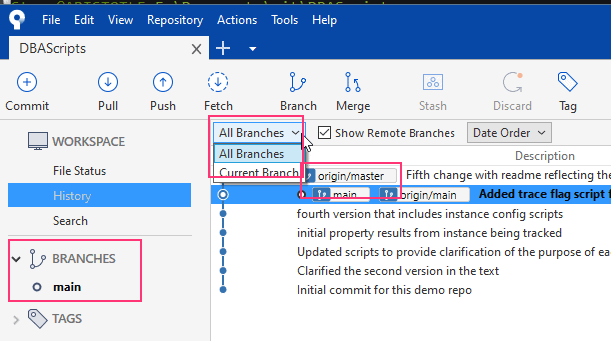

- Sourcetree update remote branches install#
- Sourcetree update remote branches password#
- Sourcetree update remote branches download#
- Sourcetree update remote branches free#
We now want to clone your fork to your local environment (a.k.a. In part 2 of this guide, we already forked the original Concrete5 repository to your account. When your account is successfully connected you will see it indicated in SourceTree and your username will appear in the Username field.Ĭlick OK and you will see your account added to the list-with your avatar if any-on the previous popup.Įt Voila! Congratulations, you’re all set-up to work and interact with any repository hosted in your GitHub account. As soon as it says you are connected or it simply stops loading, you should be good to go. It’s also not that secure.Ī window will open and load in your browser.
Sourcetree update remote branches password#
In case you’re wondering, the “Basic” authentication type uses your account’s username and password and has been deprecated by GitHub so it will stop working soon. In the popup that opens, select the “Authentication” tab and click on the “Add” button. In SourceTree, using the top menu navigate to Tools ⇒ Options.

There are several ways of doing that and we’re going to use the easiest: connection over HTTPS.įirst make sure that, in your browser, you are logged in to your GitHub account. Once SourceTree is installed we need to add your GitHub account to it. I am not sure to what extent since I don’t have a Mac, but I believe the essentials are still pretty much the same. Getting SourceTree set upīefore we start it is worth noting that SourceTree is different on Mac and Windows. While installing SourceTree, provide your BitBucket credentials and, when asked, select Git and not Mercurial (another versioning system) unless you want to give it a try.
Sourcetree update remote branches free#
In Github, you get only public repositories on the free plan. If you’re going to start using Git, it’s a good idea to have a BitBucket account since, unlike GitHub, they offer private repositories with their free accounts. BitBucket is a GitHub competitor from Atlassian, also makers of SourceTree.
Sourcetree update remote branches install#
To install SourceTree you need a (free) BitBucket account.
Sourcetree update remote branches download#
If you haven’t already, download SourceTree and install it. Posted by Nour Akalay on DecemUpdated on October 8, 2020. Let’s move on to serious stuff with SourceTree. Simple workflow optimizations like this, make me happy.The Git and SourceTree beginner's guide to contributing to open-source projects in GitHub - Part 3 - Working with SourceTreeīy now you have learned the essential concepts you need to start using Git (part 1) and have done some forking and branching in GitHub (part 2) Here I’ll name them 01-my-fork and 02-origin.īoom! SourceTree picks 01-my-fork by default! Setting your preferred remote as default So, do the ‘ol classic prefixed by numbers. Once we’ve renamed origin, SourceTree will always pick the remote that comes first alphabetically. Open the repo settings (gear in top right)Įditing remote names Changing SourceTree’s Default Remote.Git remote rename origin SproutSocial In SourceTree (I’ve never been a fan of “ origin“, it’s terribly confusing and ambiguous for those learning git). It’s safe to rename the remotes, it’s just a nickname only used locally. Perhaps to the name of owner of the repo like SproutSocial or FaceBook.

Since SourceTree always picks origin we just need to rename to anything else. Interestingly all we have to do is rename our remotes. SourceTree defaults pushing new branches to origin Renaming a remote

SourceTree defaults to originīy default SourceTree will always pick origin to push a new branch to. Depending on your workflow, you may want to set another remote as your default, let’s say my-fork for instance. When you’re pushing a new branch, SourceTree will automatically guess which remote you wish to push to by default. I’m going to talk about changing SourceTree’s default remote.


 0 kommentar(er)
0 kommentar(er)
